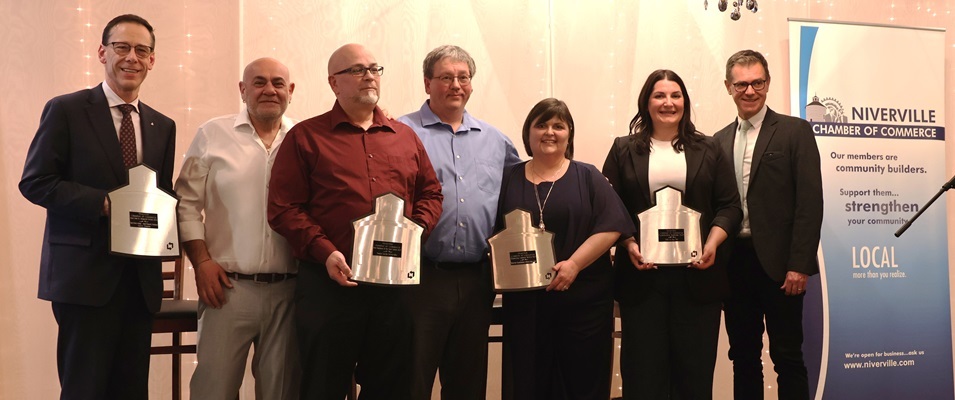
Métis and Mennonite heritage was on display as an authentic Red River cart was presented to the Town of Niverville at the Community Resource and Recreation Centre (CRRC) on Saturday, December 4.
Mayor Myron Dyck opened with a land acknowledgement, and went on to paint a detailed picture of the Métis and Mennonite partnership of the mid-nineteenth century.
“The Crow Wing Trail crosses right here,” Dyck said of the old trade route that passed through Niverville. Its location was the reason Canada Pacific Railway contractor Joseph Whitehead chose this spot to build a train station. “It created a perfect chain of supply since [Whitehead] would send men and equipment and supplies from St. Boniface.”
The expanse to the east of the Red River, to which Niverville served as an access point, was part of the land awarded to the Métis as one of the conditions for Manitoba to enter the Canadian federation.
As riverboat travel became popular, this land became ideal for early settlers, including the Mennonites who disembarked where the Rat River meets the Red. The Métis community became a valuable resource in assisting these newcomers.
“Métis men built the immigration sheds just south of here to house the first European immigrants,” said Dyck. “The Métis men provided transportation, served as guides to the settlers who really had no idea where the land was where they were to reside. Métis men helped in surveying the building sites in preparation for the construction of houses, also providing help in emergencies, natural remedies, and in general they were the people [providing help] to the Mennonites for the first decade at least.”
Cart-Building Challenges
When space was first allocated within the CRRC to showcase the region’s cultural heritage, local historians formed a committee to prepare the exhibit.
On behalf of this committee, local historian and former high school teacher Ernest Braun approached the Town of Niverville about securing a Red River cart replica. The town committed to providing a timber frame structure to preserve the cart from the elements if the historical committee could secure one.
“All we needed to do was raise $5,000 and get a cart,” says Braun. “The first one was no problem. The second, not so easy.”
Braun approached cart builders Armand and Kelly Jerome about the possibility of building a Red River cart replica, but due to scheduling constraints at the time Armand had said they were unable to commit.
“He told me that in the foreseeable future, they were overbooked,” Braun says. “And he didn’t see how it would work out, not in the timeframe we were looking at, for the opening of the cultural centre in September 2021.”
The committee explored other options, but none of those panned out.
“And then the unthinkable happened,” Braun continues. “On May 4, Armand called.”
The Jeromes now told him that they could take on the project and have one ready before Christmas.
Armand, who is of Métis descent, grew up helping his dad build furniture and developed a fascination with Red River carts when he was first asked to build one over 20 years ago in St. Norbert.
“At the time I tried to find information on building a Red River cart and I managed to get a hold of a build print,” says Armand. “My first lesson learned was ‘Don’t blindly trust blueprints.’ Those blueprints were wrong. The parts were weak… and I knew no two Red River carts would be exactly the same, but I thought they should probably be close.”
Just building a cart that looked the part was never the goal. Rather, he set out to achieve a vehicle that was as close to the specifications and quality of what was in use over a hundred years ago. Taking into account the exact degree at which the spokes should be attached to the wheel, and how to strengthen the cart rail so that the load didn’t shift, was extremely important.
“I decided to conduct my own research,” Armand adds. “I examined archival photos, comparing heights with the average Métis man at the time. I was made aware of a cart found in Minnesota and with the remains I inferred things like the correct way of constructing spokes to meet the wheels. There was a lot of trial and error. We believe these are the most historic and truly functional carts.”
The Jeromes explain that the carts are made out of oak, black ash for sideboards and shafts, elm for the hubs, as well as birch for the baskets.
Sourcing the hardwoods locally was a considerable challenge.
“We did experiment using softwoods, but it cannot handle the stress,” Armand says. “You need the amount of oak and ash in the Red River area, and there’s also elm.”
Red River Carts Connect Communities
The Jeromes and their cart-building efforts have connected them with the Métis Veterans’ Memorial Monument in Batoche, Saskatchewan, the Winter Olympics 2010 in Vancouver, as well as many museums, historic sites, and amazing community events, including an 800-mile cart journey that started in St. Norbert.
Kelly presented a copy of the filmed documentary, entitled The 800 Miles to Batoche, to the Town of Niverville for their “education and enjoyment.” In turn, Mayor Dyck announced that the Town of Niverville had made a monetary donation of $3,500 to the Jeromes in support of furthering their Métis cultural efforts.
“Red River carts have the ability to bring people together to celebrate cultures and experiences,” said Kelly at the Niverville event. “It is a labour of love for us and we sincerely hope your community will enjoy this cart for years to come.”
Armand and Kelly have participated in numerous re-enactments of cart-pulling and driving them with horses or oxen.
Recently, Armand and Braun were part of an initiative to drive an ox-pulled cart from the Mennonite Landing to Niverville. That journey was marked with challenges ranging from difficult weather to the ox refusing to walk.
“It’s been an honour to work with the Mennonite people,” says Armand. “To re-enact the Mennonite Landing, depicting the Métis people assisting the newly arrived immigrants to Canada, we are proud to have the Métis culture proudly displayed here in Niverville. History repeats itself.”
Reclaiming Heritage
It’s a history that is newly important to one Niverville resident who attended the historical presentation after learning about her own Métis heritage for the first time.
Rose Steinke grew up in Otterburne, previously lived in The Pas, and now lives at the Heritage Centre with her husband Larry. She first learned about a new branch of her family tree just a few years ago through her cousin.
“I even brought my Métis card to show you that I am,” said Steinke with visible pride. “We found out by doing the family genealogy. I have a cousin that does that. She researches, and we found out that our great-great-grandmother was Cree.”
Since then, Steinke’s interest in local history has only grown. She’s spent considerable time discovering more about the cultural ties she didn’t know she had.
“Ever since then, I’ve had an interest in learning about the Métis,” said Steinke. “It’s amazing what they went through when they first came. They did a lot here and were an important part of establishing themselves and the area we know of in Manitoba. I was amazed.”
Steinke encourages more Niverville residents to take a look at their family history to see if they have any Métis connections.
“I wouldn’t be surprised if more people had a story like mine,” she said. “You could have a whole side of your heritage you don’t know about.”
Steinke spent some time observing the Red River cart despite the cold weather and making connections with others at the event.
The Last of the Red River Carts
The Jeromes are concerned for the future of cart-building and the trail drives. The time they’ve spent in research, dedication to historical accuracy, woodworking materials, and caring for oxen and horses has come at a high cost.
“We’re not sure what the future of cart-building will be after we’re done,” says Armand. “The work is hard, the wood is expensive, and we’re not getting any younger. The artisans and animal care providers must be skilled. Will anyone in the future have the same passion?”
Braun agrees that the future is uncertain and full of challenges.
“At this point in time, cart-making is a lost art,” Braun says. “And in view of imminent retirement, Kelly is incorporating every detail into a manual. This will be a priceless contribution to material culture of Manitoba and of the Métis. So we, the Town of Niverville, are the beneficiaries of what might be one of the last carts made by Jerome Cartworks.”
Armand is proud to have had the opportunity to work on this important historical project.
“Having a Red River cart here to help future generations understand the connection between the Métis and Mennonite will go beyond mere words,” Armand says. “This, we hope, will be a lasting monument and we are privileged to be a part of the project.”
The Cart Exhibit
The museum exhibit on the second floor of the CRRC provides a detailed history for everyone who would like to retrace the local history of the Métis, Mennonite, French, and other immigrants who settled in this area.
“[This cultural space] was designed to help us remember our heritage and our history,” says Mayor Dyck. “It’s an opportunity for our children and our children’s children to ask questions about and say, ‘How did this happen? Why did this happen? Who are we?’ And so we are grateful to this wonderful idea and appreciate it so much.”
Outside, the cart is positioned on a concrete pad at the south end of the parking lot in front of the Niverville Centennial Arena.
When warmer weather allows, the town will fund a timber-frame shelter to house the cart. They also plan to coordinate with the Steinbach Regional Secondary School carpentry program to involve local students in the construction project.




















